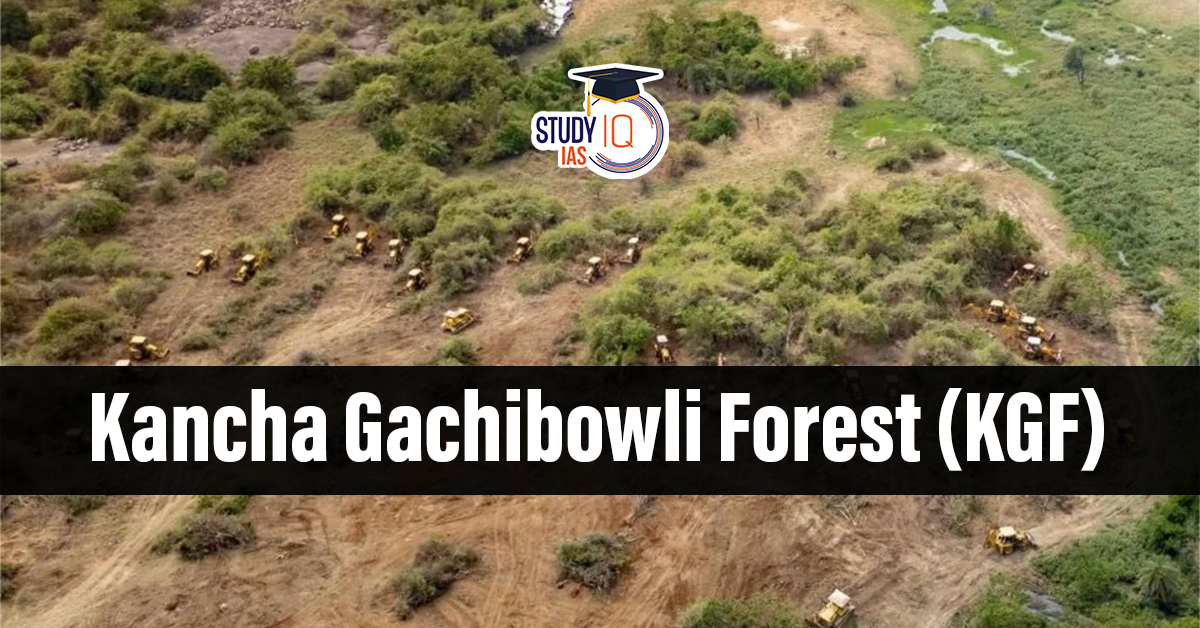Context: For weeks, the 400-acre Kancha Gachibowli Forest (KGF) near the University of Hyderabad (UoH) has been at the center of a fight over Hyderabad’s urban development.
More in News
- According to students and the university community, Kancha Gachibowli is part of the university’s original campus land, granted in 1974.
- The government denies this claim.
- Recently Telangana govt. has decided to auction the land and clear the forest area.
Significance of Kancha Gachibowli Forest (KGF)
- Hyderabad’s “Green Lung”: Kancha Gachibowli Forest (KGF) is often called the city’s “green lung” due to its role in improving air quality and regulating local temperatures.
- Biodiversity Hotspot Within An Urban Setting: It is home to over 734 species of flowering plants, 10 species of mammals, 15 species of reptiles, and 220 species of birds.
- 27 bird species are protected under Schedule I of the Wildlife Protection Act, 1972.
- 32 species flagged as high conservation priorities in the 2023 State of India’s Birds
| Some key species found in Kancha Gachibowli |
- Tree Trunk Spider (Murricia hyderabadensis): an endemic species found nowhere else in the world.
- Indian Roller: the bright blue state bird of Telangana.
- Oriental Skylark: known for its melodious song.
- Monitor Lizards: crucial for pest control in the food web.
- Bronze-Backed Tree Snake: a non-venomous snake native to this region.
- Flame of the Forest (Butea monosperma): a vibrant native tree species.
|
- Hydrological Significance: Located at the highest point in the Manjira basin, the forest helps:
- Prevent urban flooding
- Recharge freshwater lakes (e.g., Peacock Lake and Buffalo Lake)
- Climate Regulation: The forest acts as a natural climate regulator, mitigating urban heat and contributing to air quality.
Impact of deforestation of Kancha Gachibowli Forest (KGF)
- Loss of Biodiversity: Deforestation of Kancha Gachibowli Forest (KGF) threatens the inhabited species by destroying their natural habitat.
- Climate Disruption in Neighbouring Areas: Destruction of the forest could raise local temperatures by 1–4°C in areas like Tellapur, Nallagandla, and Gachibowli, worsening urban heat island effects.
| Fact |
| The urban heat island (UHI) effect is when cities experience significantly higher temperatures than surrounding rural areas due to factors like reduced vegetation, dense infrastructure, and human activities |
- Violation of Public Trust Doctrine: Environmentalists contend that the auctioning of Kancha Gachibowli Forest (KGF) violates the public trust doctrine, which mandates the government to protect and maintain natural resources for public use.
- Human-Wildlife Conflict: Destroying this forest will increase human-wildlife conflict, as displaced animals will seek food and shelter in urban areas.
- Increased Pollution: Removing this green cover diminishes the city’s capacity to filter air, leading to higher concentrations of airborne pollutants.
- Violation of Environmental Laws: Activists argue that clearing forest land containing protected species without conducting an Environmental Impact Assessment (EIA) or obtaining Environmental Clearance violates environmental and wildlife protection laws.
| Key Movements Against Deforestation |
- In 1730, Amrita Devi from Khejarli village, Rajasthan, courageously opposed the Maharaja of Jodhpur’s orders to cut down trees.
- As she and 363 members of her Bishnoi tribe hugged the trees in protest, they were brutally executed.
- This sacrifice led the Maharaja to impose a ban on tree-cutting in the region.
- Silent Valley Movement (1973-198:5): Protest against a hydroelectric project in Kerala to protect biodiversity.
- Chipko Movement (1973): A grassroots movement in Uttarakhand against deforestation.
- Bhopal Gas Tragedy (1984): A major industrial disaster that intensified discussions on environmental regulations.
- Buxwaha Forest Diamond Mine Protest (2021): Over 200,000 trees were expected to be cut in the Buxwaha forest for the diamond project.
- This led to widespread protests, legal challenges, and social media campaigns aiming to halt the project and protect the Buxwaha forest.
- Nandgaon Solar Plant Opposition (2025): In Nandgaon, Maharashtra, local farmers protested against Tata Power’s proposed 100-megawatt solar development.
- The farmers, who had cultivated the land for generations, viewed the project as a corporate land grab, leading to legal disputes and halting the project’s progress.
|
What are Arguments in Favor of the Kancha Gachibowli Forest (KGF) Destruction?
- Infrastructure Expansion: Proponents argue that developing the 400-acre land will facilitate the growth of IT infrastructure, improve connectivity, and create sustainable urban spaces, aligning with the government’s priorities for Hyderabad’s development.
- Revenue Generation: The Telangana Industrial Infrastructure Corporation (TGIIC) anticipates that auctioning the land could generate significant revenue, estimated at ₹28,000 crores, contributing to the state’s economic growth.
- Moreover, this will attract potential investments of Rs 50,000 crore, and generate as many as 5 lakh jobs.
- Preservation of Key Features: TGIIC has stated that notable natural features, such as the Mushroom Rock formation, will be preserved as green spaces within the development layout, suggesting an effort to balance development with environmental considerations.
| How Development in Urban Centres Impacts the Environment |
- Deforestation and Habitat Loss: Expansion of cities, industries, and agriculture leads to large-scale deforestation.
- Mature trees provide critical ecosystem services (carbon sequestration, habitat for birds and small mammals, microclimate regulation) that cannot be easily replaced.
- Example: Aarey Forest (Mumbai) clearance for Metro project led to protests.
- Air and Water Pollution: Industrialization and urbanization increase air pollution (CO₂, PM2.5, NOx emissions).
- Water bodies get contaminated due to untreated sewage and industrial effluents.
- Example: Ganga and Yamuna rivers face severe pollution despite cleaning efforts.
- Climate Change and Global Warming: Fossil fuel consumption in industries, transport, and power plants raises greenhouse gas emissions.
- This leads to rising temperatures, erratic rainfall, and extreme weather events.
- Example: Heatwaves in India(2023) linked to climate change due to urban expansion.
- Soil Degradation and Desertification: Overuse of chemical fertilizers, mining, and deforestation deplete soil fertility.
- Urban expansion and infrastructure projects reduce arable land.
- Example: Thar Desert is expanding due to overgrazing and deforestation in Rajasthan.
- Water Scarcity and Groundwater Depletion: Excessive water extraction for irrigation, industries, and urban areas lowers groundwater levels.
- Dams and river diversions disrupt natural water flow and aquatic ecosystems.
- Example: Bangalore and Chennai face water crises due to over-extraction of groundwater.
- Loss of Indigenous Livelihoods: Infrastructure projects like dams, highways, and mining displace tribal and rural communities.
- Traditional occupations like farming and fishing are impacted.
- Example: Hasdeo Aranya (Chhattisgarh) coal mining project threatens tribal land and forests.
- Replacement Challenges: The practice of “planting 10 times more trees” as a mitigation is misleading since replanted trees often cannot match the ecological value of mature trees.
- There is a lack of scientific rigour in counting and ensuring the quality of replacement tree cover.
- Loss of Wetlands: India has already lost one-third of its wetlands in the past four decades, largely due to urbanisation and pollution, according to Wetlands International South Asia (WISA).
- Loopholes in Governance: Laws like the Environment Protection Act (1986), Forest Conservation Act (1980), and EIA (Environmental Impact Assessment) exist.
- However, the dilution of environmental regulations to favour industries often leads to conflicts.
|
What Lies Ahead for Kancha Gachibowli Forest
- Supreme Court’s Crucial Verdict (April 16): The interim stay by the Supreme Court is a temporary win for environmentalists. The upcoming hearing will determine whether the forest receives long-term legal protection and whether an independent ecological assessment will be made mandatory before further development.
- Strengthening of Grassroots Movements: The movement led by students, ecologists, and citizens is gaining momentum. Symbolic actions—like tying sacred threads on trees and planting saplings—are not just protests but declarations of ecological commitment. This kind of civic engagement could influence policy and inspire future environmental activism.
- Ripple Effects Across Cities: Inspired by Kancha Gachibowli, similar eco-resistance is emerging in Warangal, Visakhapatnam, and Delhi, indicating a broader urban ecological awakening across India.
- Push for Ecological Urban Planning: The case has spotlighted the need for scientific environmental impact assessments before approving urban projects. It could serve as a test case for embedding ecological sensitivity into India’s urban planning
- A New Narrative for Indian Cities: The resistance is not just about halting bulldozers—it’s about redefining progress. The vision ahead is one where cities are designed for coexistence between nature and people, rooted in sustainability, care, and community.
Sharing is caring!


 Salt Pan Land Cleared for Dharavi Redeve...
Salt Pan Land Cleared for Dharavi Redeve...
 Kerala and Tamil Nadu Unite for Nilgiri ...
Kerala and Tamil Nadu Unite for Nilgiri ...
 Carbon Emissions From Wildfires, Implica...
Carbon Emissions From Wildfires, Implica...





















